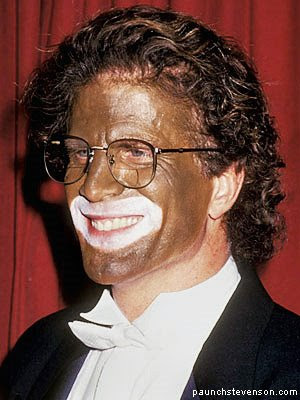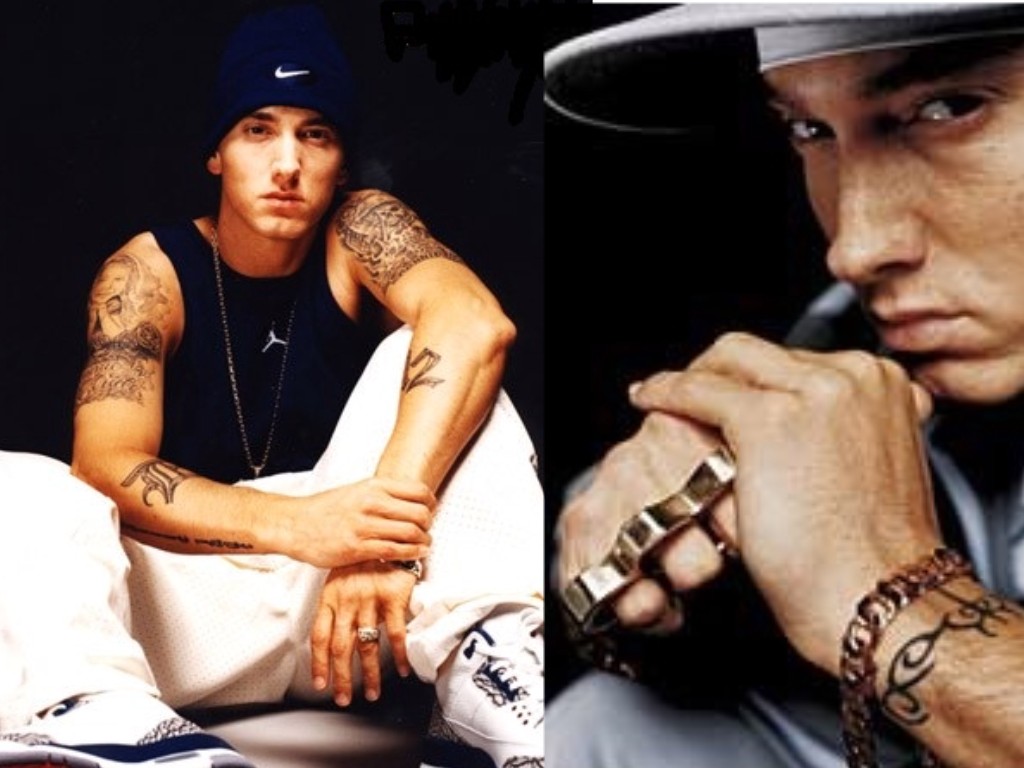Basic Elements of Blackface
Now that the definitions of Blackface Minstrelsy and its many spin-offs have been explained on the Racial Performance page, a quick reiteration of the three commonly studied and necessary markers, or elements, of Blackface must be made. Can you name them?
1.) Stereotypes to portray- The Parody of the Average Black
2.) Paint- The Perversion of Appearance to Resemble the Parody
3.) Removable Mask- The Audience's Knowledge of the Audience's Whiteness
Now it's time to apply these markers...
| Ted Danson at the Friar’s Club in his birthday roast tribute to then girlfriend Whoopi Goldberg in 1993. |
 |
As previously mentioned the Racial Performance page, traditional representations of Blackface Minstrelsy are still used today for historical purposes, although on a rare occasional, its use for satirical entertainment will pop up in daily life. In 1993, a celebrity incident involving unintentional blackface rocked the prestigious Friar's Club in New York (Facts 1). Actor Ted Danson was participating in a roast of his then girlfriend Whoopi Goldberg, using actual brown make up and a wig as well as offensive racial and sexual humor, suggesting that blackface is not just paint and costumes, but a style of entertainment (Fact 1). The paint in this incident was literal, and the audience knew that the performer was her white boyfriend, but the implementation of the first marker, the stereotype, was personal and specific to one woman, and not a generalization. Simply by dressing as a black woman and joking harshly toward her, one can cross the line into Blackface satire.
Why not observe a more nontraditional instance of Blackface? Consider the case of Robert Van Winkle, a performer raised in the predominantly white, upper-middle class suburbs of Dallas, TX (Scott and Cole 1). He attempted to enter the hip-hop music industry in the early nineties. Unfortunately for Robert, "in the late eighties and early nineties, one's identity performance as a rapper was supposed to be a reflection of the 'real' world', and so rap took a particularly autobiographical turn" (White 353). His "real life" didn't quite line up with the current era's "preoccupation with 'keeping it real'", so he and the team at SBK records manufactured a more suitable persona, in keeping with the assumed ideals and values of a urban rapper (White 353). Wearing the latest garb of a fashionable black urban youth and always seen posing in threatening stances to suggest his street toughness (the paint), he claimed to have attended Miami's Palmetto High School, the same alma mater as a Luther Campbell of the notorious 2 Live Crew, and have won three national motorcross championships (the stereotype) before he achieved hip-hop stardom (Scott and Cole 1).
According to Billboard.com, his album To the Extreme remained on the charts for sixty-seven weeks in 1990, immortalizing songs like Ice, Ice, Baby and Robert's own tribute to Play that Funky Music, a song made famous by a black band led by a white singer. Who was the musical phenom? Robert Van Winkle chose a stage name influenced by the times. Rappers Iced Tea, a former street pimp, and Ice Cube, a member of the infamous group NWA, inspired him to choose a name that played at his actual race (the removable mask). Robert, better know as Vanilla Ice, was outed by the students of Palmetto High School as a phony, initializing his subsequent fall from grace (Scott and Cole 1).
 |
Vanilla Ice, AKA Robert Van Winkler, on the cover of his 1990 album "To the Extreme". |
Another example of this cultural phenomenon is actually accepted by the hip-hop music community. Marshall Mathers, has been performing before multicultural audiences for several albums now, successfully bridging white America to urban life from the safe distance of rap music. At first glance, his short-cropped hair, his dark, loose-fitting clothing, and his constantly angry expressions (the paint) only further the persona he portrays. Sadly, his rocky domestic life mirrors the ideas many Americans associate with black families and his multiple arrests for domestic abuse solidify the belief that he condoned these values (the stereotype). His music reflected his constant anger in comically belligerent manner, endearing him to fans. He chose the stage Eminem, but the world soon grew to know him as Slim Shady, the second persona he adopted perform with abandon and no recourse. Slim Shady was the uncontrollable entity, yet Marshall was the real man, and Eminem was the performer allowed to shed the "shadiness" when the camera stopped rolling. While "Eminem’s performance articulate[d] and tap[ped] into contemporary frustrations felt by poor working-class white males", Slim Shady's performance "performance draws upon and merges together elements of black vernacular street culture primarily associated with the urban North and white ethnic cultural allusions drawn from slasher films and Southern rural horror (White 66).” By completely dissociating from the persona portrayed on stage, Marshall Mathers created a mask that he could not only remove but for which he could deny any real responsibility.
| Eminem, AKA "Slim Shady" AKA Marshall Mathers |
 |
This performance of race for entertainment has not just recently returned, but rather, has evolved since the creation of rock and roll. Attributing the creation of a genre of music to a social contruct as unfounded as race may seem unreasonable, but to the performers robbed of the entitlement of such feat, it is necessary. Critics like George Nelson argue that "the appropriation of the language and style of black-identified music forms and their attendant (sub)cultures by white musicians and audiences represents a form of cultural piracy (White 67).” Performers like Little Richard and Chuck Berry never received the due monetary appropriation that their actual roles in rock and roll's founding demanded (Chappell 52). According to Tim Moore, the communications director for the Rock and Roll Hall of Fame and Museum in Cleveland, white artists would often "cover" songs written by blacks years earlier and emulate their dress and dance styles, never sharing the profits with the original artists. (Chappell 52).
 |
The late, great Elvis Presley |
"The music of the Black Church and the music of the blues are the bedrock ofwhat became known as rock 'n' roll inthe early 1950s…White artists made the money, and White America was finally able to openly embrace and dance to the music, which they had long listened to on Black-formatted radio stations in the privacy of their homes (Chappell 53).” The most commonly argued case of cultural piracy in the black community is Elvis Presley, and he did emulate black culture, dressing in styles associated with blacks, hanging out in black Memphis jazz clubs, and recording his own version of the African-American songbook. However, he acknowledged this emulation, giving credit to the original (black) sources of his music (McKeen 24). If his dance style and late night jazz club rendevues qulaified as portraying stereotypes, his black culture-inspired clothing was appropriate paint, and his credence to black sources for his music was a removable mask, Elvis Presley was performing unintentional racial burlesque in the 1950s, implying that Blackface hasn't returned, because it never truly left.
| Left to Right: Little Richard and Chuck Berry in concert |
 |
Works Cited
Chappell, Kevin. "How Blacks Invented Rock and roll." Ebony January 1997: 52-56. EBSCOhost. Web. 22 Nov. 2010.
"Facts on File: World news Digest." People in the News 14 October 1993: n. Facts on File. Web. 31 Oct. 2010.
McKeen, William. "What We Talk About when We Talk About Elvis." American History August 2007: 20-29. EBSCOhost. Web. 1 Nov. 2010.
Scott, S. and W. Cole. "Flavor of the Month." Time 10 December 1990: 105. EBSCOhost. Web. 1 Nov. 2010.
White, Russell. "Behind the Mask: Eminem and Postindustrial Minstrelsy." European Journal of American Culture 25.1 (2006): 65-79. EBSCOhost. Web. 1 Nov. 2010.
Comments (0)
You don't have permission to comment on this page.